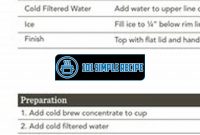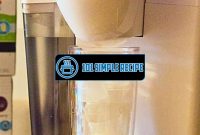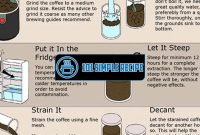Are you ready to unlock the secrets of the perfect cold brew coffee? Look no further, because in this article, we will guide you through the art of making cold brew coffee like a pro. Whether you are a coffee enthusiast or simply want to savor a refreshing and smooth caffeine delight, this comprehensive guide is tailored just for you. From the equipment needed to the step-by-step process, we’ve got you covered. So grab your favorite mug and get ready to embark on a chilly adventure that will awaken your taste buds and keep you energized throughout the day! ☕️

Understanding Cold Brew Coffee
Discover what cold brew coffee is and why it has become increasingly popular amongst coffee enthusiasts.
What is Cold Brew Coffee?
Cold brew coffee is a brewing method that involves steeping coarse coffee grounds in cold or room temperature water for an extended period of time. Unlike traditional brewing methods that use hot water, cold brew relies on time rather than temperature to extract the flavors from the coffee beans.
Key Point: Cold brew coffee is made by steeping coarse coffee grounds in cold or room temperature water for a long period of time.
This slow extraction process creates a concentrated coffee concentrate that is less acidic and smoother in taste compared to hot brewed coffee. The resulting cold brew concentrate is often diluted with water or milk before being served over ice.
Key Point: Cold brew coffee has a less acidic and smoother taste compared to hot brewed coffee.
The Difference Between Cold Brew and Iced Coffee
While cold brew and iced coffee are both served cold, there are distinct differences in how they are made. Iced coffee is made by brewing hot coffee and then pouring it over ice to cool it down quickly. On the other hand, cold brew coffee is made by steeping coffee grounds in cold or room temperature water without any heat involved.
Key Point: Iced coffee is made by pouring hot coffee over ice, while cold brew coffee is made by steeping coffee grounds in cold water without any heat.
Another difference lies in the strength and flavor profiles of the two beverages. Cold brew coffee is typically stronger and has a smoother taste compared to iced coffee. The slow extraction process of cold brew results in a more concentrated coffee flavor, whereas iced coffee can sometimes taste watered down due to the melting ice.
Key Point: Cold brew coffee has a stronger flavor compared to iced coffee.
Benefits of Cold Brew Coffee
Cold brew coffee has gained popularity among coffee enthusiasts due to its unique characteristics and benefits. Here are some of the key advantages of cold brew coffee:
- Less acidity: Cold brew coffee has lower acidity levels compared to hot brewed coffee, making it a gentler option for those with sensitive stomachs.
- Smooth taste: The slow extraction process of cold brew results in a smoother and less bitter taste, allowing the natural flavors of the coffee beans to shine through.
- Reduced bitterness: Cold brew coffee is known for having a milder bitterness compared to hot brewed coffee, making it more enjoyable for those who prefer a less intense flavor profile.
- Longer shelf life: Due to its low acidity and concentrated form, cold brew coffee can be stored in the refrigerator for up to two weeks without losing its flavor or freshness.
- Versatile usage: Cold brew coffee concentrate can be used as a base for various coffee beverages such as iced lattes, mochas, or even cocktails.
Key Point: Cold brew coffee has the benefits of lower acidity, smoother taste, reduced bitterness, longer shelf life, and versatile usage.
As the popularity of cold brew coffee continues to grow, more and more people are discovering the unique flavors and benefits this brewing method offers. Whether you prefer it straight, with milk, or as part of a creative coffee concoction, mastering the art of making cold brew coffee allows you to enjoy a refreshing and flavorful cup of joe.
If you’re interested in other coffee recipes, you can try making White Castle burgers or weight loss recipes.
Equipment and Ingredients Needed
Learn about the essential equipment and ingredients required to make a delicious batch of cold brew coffee.
Brewing Container
When it comes to making cold brew coffee, having the right brewing container is crucial. Look for a container that is specifically designed for cold brewing, such as a glass pitcher with a built-in filter or a cold brew coffee maker. These containers are designed to steep the coffee grounds in cold water for an extended period, allowing the flavors to be extracted slowly and resulting in a smooth, less acidic brew.
Important Note: Avoid using containers made of plastic or metal as they may alter the taste of your cold brew coffee.
Coffee Beans
The quality of your coffee beans plays a significant role in the flavor of your cold brew coffee. Opt for a coarse grind to prevent the coffee from becoming bitter or over-extracted. Choose beans that are specifically labeled for cold brewing to ensure the best results. These beans are typically roasted to a specific level to enhance the flavor profile when brewed cold.
Note: Experiment with different coffee bean varieties to discover your preferred flavor profile. Some popular choices include light roasts with fruity undertones or dark roasts with chocolatey notes.
Water Quality
Water quality is often overlooked, but it can greatly impact the taste of your cold brew coffee. Use filtered water or spring water to ensure a clean and pure taste. Avoid using tap water as it may contain impurities or alter the flavor of your brew. Cold brew coffee relies heavily on water, so choosing the right quality is essential.
Note: If possible, use water that has been filtered through a water purifier or a reverse osmosis system for the best flavor.
By ensuring you have the right equipment and quality ingredients, you can master the art of making cold brew coffee. Remember to experiment and adjust the ratio of coffee to water based on your personal taste preferences. With time and practice, you’ll be able to enjoy a refreshing cup of homemade cold brew coffee whenever you desire.
The Cold Brewing Process
Are you ready to master the art of making cold brew coffee? Let’s dive into the step-by-step process, starting from grinding the beans all the way to steeping and filtering.
Grinding the Coffee Beans
The first step to making the perfect cold brew coffee is to grind the coffee beans. This is an essential step as it determines the flavor and strength of your brew. For cold brew, you will need a coarse grind. This allows for a slower extraction process, resulting in a smoother and less acidic cup of coffee. If you don’t have a coffee grinder at home, you can always ask your local coffee shop to grind the beans for you.
Now, let’s take a closer look at the grinding process. Start by measuring the desired amount of coffee beans. A good rule of thumb is to use a 1:4 coffee-to-water ratio for a concentrated cold brew. Next, add the beans to your grinder and pulse a few times until you achieve a coarse consistency. Remember not to over-grind the beans as it can lead to bitterness in your brew. Once the beans are ground, transfer them to a clean container for the next step.
Steeping the Coffee Grounds
Now that you have the ground coffee ready, it’s time to move on to the steeping process. This is where the magic happens and the flavors of the coffee infuse with the water.
To start, fill a large container or jar with cold, filtered water. Cold brew requires a longer steeping time, so patience is key. Add the ground coffee to the water and give it a gentle stir to ensure all the grounds are fully saturated. Secure the lid on the container and let it steep in the refrigerator for at least 12-24 hours. This allows the coffee to slowly extract its flavors and oils, resulting in a rich and smooth brew.
During this steeping process, it’s essential to resist the temptation to stir the mixture further. Stirring can agitate the coffee grounds and lead to a bitter taste in your final brew. So, let the coffee work its magic without any interference.
Filtering the Brew
After patiently waiting for the steeping period to finish, it’s time to filter out the coffee grounds and enjoy the fruits of your labor.
To begin, place a fine-mesh sieve or a coffee filter over a clean container or pitcher. Slowly pour the steeped coffee and allow it to pass through the filter. This will separate the coarse grounds from the liquid. For a clearer brew, you can even use a cheesecloth to strain the coffee further.
Once the coffee is filtered, you will be left with a smooth and flavorful cold brew concentrate. This concentrate can be diluted with water, milk, or your preferred liquid to achieve the desired strength. Remember, cold brew is highly concentrated, so it’s best to start with a 1:1 ratio of concentrate to water and adjust according to your taste preference.
Now that you know the ins and outs of the cold brewing process, you are well-equipped to create your very own delicious cold brew coffee at home. Enjoy experimenting with different beans, ratios, and brewing times to discover your perfect cup of cold brew!
Experimenting with Cold Brew Recipes
Discovering the world of cold brew coffee is an exciting journey filled with unique flavors and refreshing concoctions. In this section, we will explore different variations and creative ways to enjoy your cold brew coffee by adding flavors and toppings.
Adding Syrups and Flavored Creamers
Enhancing your cold brew coffee with syrups and flavored creamers can take your drink to a whole new level of deliciousness. Whether you prefer a sweet, caramel flavor or a subtle hint of vanilla, there are endless options to choose from.
- Caramel Syrup: Adding a drizzle of caramel syrup to your cold brew coffee adds a touch of sweetness and a delightful caramel flavor.
- Vanilla Flavored Creamer: For a creamy and fragrant twist, consider adding a splash of vanilla flavored creamer to your cold brew coffee.
- Hazelnut Syrup: If you love the rich, nutty taste of hazelnuts, a dash of hazelnut syrup in your cold brew coffee will satisfy your cravings.
Experiment with different combinations and ratios to find the perfect balance of flavors that suits your taste buds. Whether you prefer a subtle hint of flavor or a bold, robust taste, these syrups and creamers will add a delightful twist to your cold brew coffee.
Using Different Types of Milk
The choice of milk can greatly influence the taste and texture of your cold brew coffee. By exploring different types of milk, you can create unique and enjoyable experiences with each sip.
- Almond Milk: If you are looking for a dairy-free alternative, almond milk adds a nutty and slightly sweet taste to your cold brew coffee.
- Coconut Milk: For a tropical twist, coconut milk brings a creamy and exotic flavor to your cold brew coffee.
- Oat Milk: With its creamy texture and subtle sweetness, oat milk is a popular choice for cold brew coffee enthusiasts.
Each type of milk has its own unique qualities that can enhance the overall taste of your cold brew coffee. Whether you prefer a creamier texture or a milder flavor, experimenting with different types of milk can add a delightful twist to your daily brew.
Creating Cold Brew Coffee Cocktails
If you’re a fan of both coffee and cocktails, why not combine the two? Cold brew coffee cocktails are a fantastic way to add a little bit of excitement to your beverage repertoire.
You can create a variety of cold brew coffee cocktails by mixing your cold brew coffee with other spirits and flavorings. Here are a few ideas to get you started:
- Espresso Martini: Combine your cold brew coffee with vodka, coffee liqueur, and a touch of simple syrup for a sophisticated and energizing cocktail.
- Iced Irish Coffee: Mix your cold brew coffee with Irish whiskey, a hint of brown sugar, and top it off with a dollop of whipped cream. It’s a refreshing twist on a classic favorite.
- Coffee Old Fashioned: Transform your cold brew coffee into a stylish and bold cocktail by combining it with bourbon, a dash of simple syrup, and a few dashes of aromatic bitters.
Feel free to experiment with different spirits, mixers, and garnishes to create your own unique cold brew coffee cocktail. The possibilities are endless!
Looking for more refreshing drinks? Check out our recipe for punch bowl or try making cookie in a mug.
Storing and Serving Cold Brew
When it comes to enjoying a refreshing cup of cold brew coffee, proper storage and serving techniques are essential to maintain its freshness and taste. Whether you prefer storing your cold brew in the refrigerator, serving it over ice, or using cold brew concentrate, here are some best practices to master the art of making cold brew coffee and enhance your coffee-drinking experience.
Storing Cold Brew in the Refrigerator
To keep your cold brew coffee fresh and flavorful, storing it in the refrigerator is crucial. The cold temperature helps to slow down the oxidation process and preserve the delicate flavors of the coffee. When storing your cold brew, make sure to follow these steps:
- Use an airtight container: Transfer your cold brew into a clean, airtight container to prevent any outside odors from seeping in and affecting the taste. This will also keep your cold brew fresher for a longer period.
- Keep it away from light: Light can cause your cold brew coffee to deteriorate quickly. Store the container in a dark spot or use an opaque container to block out any light.
- Mark the date: It’s important to keep track of when you made the cold brew. Cold brew coffee is best consumed within 1-2 weeks of brewing, so mark the date on the container to ensure you enjoy it at its best.
- Avoid temperature fluctuations: Try to keep the refrigerator temperature consistent to prevent any fluctuations that may affect the quality of your cold brew coffee. Avoid placing the container near the refrigerator door, as it can be exposed to frequent changes in temperature.
- Do not freeze: While it may be tempting to freeze your cold brew for later use, freezing can alter the taste and texture of the coffee. It’s best to enjoy your cold brew while it’s fresh.
Serving Cold Brew over Ice
Serving your cold brew over ice is a popular and refreshing option, especially during hot summer days. Follow these tips to ensure a delightful cold brew experience:
- Choose the right ice: Larger ice cubes or spheres melt slower, reducing dilution and keeping your cold brew flavorful for a longer time. Consider investing in silicone ice molds to create larger, slow-melting ice cubes.
- Add a splash of milk or sweetener: Customize your cold brew by adding a splash of milk, cream, or your favorite sweetener. This can enhance the flavors and create a smooth, well-balanced cold brew coffee.
- Garnish with fresh ingredients: Elevate your cold brew presentation by adding fresh mint leaves, lemon or orange slices, or even a cinnamon stick. This adds an extra layer of aroma and visual appeal to your cold brew.
- Use a straw or sip it slowly: Using a straw or sipping your cold brew slowly allows you to savor the flavors and enjoy the intricate nuances of your cold brew coffee.
Using Cold Brew Concentrate
Cold brew concentrate offers a convenient and versatile way to enjoy cold brew coffee. Here’s how you can make the most of it:
- Decide on the strength: Cold brew concentrate is highly concentrated, so you can adjust the strength of your coffee by diluting it with water, milk, or a combination of both. Experiment with different ratios to find your preferred flavor profile.
- Store it properly: Similar to regular cold brew, store your cold brew concentrate in an airtight container in the refrigerator. This will help maintain its freshness and prevent any flavor degradation.
- Use it in recipes: Cold brew concentrate is not limited to just a refreshing cup of cold brew. Get creative and use it as an ingredient in various recipes, such as smoothies, cocktails, or even baked goods.
- Experiment with flavors: Cold brew concentrate serves as an excellent base for flavor infusions. Consider adding vanilla extract, caramel syrup, or even spices like cinnamon or nutmeg to enhance the taste and create a unique flavor profile.
By following these recommendations for storing and serving your cold brew coffee, you can ensure that each cup is a delightful and refreshing experience. Whether you prefer sipping it over ice, enjoying it with your favorite additives, or exploring the versatility of cold brew concentrate, mastering the art of making cold brew coffee is now within your reach.
If you have a furry friend, you might be interested in making dog food using Nature’s Recipe.
Thank you for reading our article on how to make cold brew coffee. We hope you found the information helpful and that you’re excited to try making your own cold brew at home. Remember, the key to a delicious cold brew is using quality coffee beans and giving them plenty of time to steep. So grab your favorite coffee beans, a jar, and some water, and start brewing your own refreshing cold brew coffee today. Don’t forget to bookmark our website and visit again for more coffee-related tips and tricks. Cheers!
Frequently Asked Questions
Here are some frequently asked questions about making cold brew coffee:
| No. | Questions | Answers |
|---|---|---|
| 1 | What type of coffee beans should I use for cold brew? | You can use any type of coffee beans for cold brew, but it’s best to choose beans that are known for their bold and smooth flavors. Some popular choices include Colombian, Ethiopian, and Brazilian beans. |
| 2 | How long should I steep the coffee? | For cold brew, it’s recommended to steep the coffee for at least 12 hours. However, you can experiment with steeping times to find your preferred strength and flavor. |
| 3 | Do I need any special equipment to make cold brew coffee? | While there are dedicated cold brew coffee makers available, you can make cold brew at home with a glass jar or pitcher and a fine-mesh sieve or cheesecloth for straining. |
| 4 | Can I drink cold brew coffee hot? | Yes, you can heat up cold brew coffee if you prefer to drink it hot. Simply pour it into a mug and microwave it to your desired temperature. |
| 5 | How long does cold brew coffee last? | Cold brew coffee can be stored in the refrigerator for up to two weeks. Just make sure to keep it in a sealed container. |
| 6 | Can I add milk or sweeteners to cold brew coffee? | Absolutely! Cold brew coffee pairs well with milk, cream, or sweeteners like sugar or flavored syrups. Customize it to your taste preferences. |
Closing Thoughts
Thank you for joining us on this journey to discover how to make the perfect cold brew coffee. We hope you enjoyed learning the step-by-step process and are eager to try it out for yourself. Remember, cold brew coffee is a great way to enjoy a refreshing cup of joe, especially during the hot summer months. So don’t hesitate to gather your ingredients and start brewing your own batch of delicious cold brew coffee. We’ll be here to guide you through more coffee adventures in the future. Stay caffeinated and keep exploring the world of coffee!
Jump to Recipe
Cold Brew Coffee

Learn how to make smooth and refreshing cold brew coffee with this easy recipe.
- 1 cup coarsely ground coffee beans
- 4 cups cold water
- In a jar or pitcher, combine the coffee grounds and cold water. Stir gently to make sure all the grounds are soaked.
- Cover the jar or pitcher and refrigerate for at least 12 hours, allowing the coffee to steep.
- After steeping, place a fine-mesh sieve or cheesecloth over another jar or pitcher. Slowly pour the cold brew through the sieve to remove the coffee grounds.
- Serve the cold brew coffee over ice and enjoy. You can customize it with milk, cream, or sweeteners if desired.






